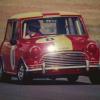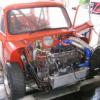
Castor Measurement - Explanation Required
#1

Posted 12 March 2012 - 11:05 PM
The guy said they had adjusted the tracking to the correct tolerance, but the castor was out. In other words, the near side wheel is further back in the arch than the offside by approx. 10mm.
He said that it would be fine if the car felt OK; which it does, there is no pulling to one side or other strange feelings through the steering and the handling feels fine.
But I was just wondering what the long term implications would be. I assume that if the tracking is OK, tyre wear will be equal across the tread.
Even though I have spent money on new fixed length tie rods; would it be better to fit adjustable ones to bring the castor back where it should be; i.e. even on both sides; or will it be OK.
He will be using the car for mainly local journeys with no motorway or high speed work (after all; it's only a 998cc!!!)
Opinions welcome on this one please
Thanks
#2

Posted 13 March 2012 - 03:00 AM
That said, the three main variables are camber, caster, and toe (tracking). It sounds like they adjusted the toe for you. That will affect tire wear significantly. When set incorrectly it can also cause vibration. Camber is how the wheel leans into or away from the centerline of the car. When the camber is out of adjustment the car can pull badly from one side or the other... or the car can feel "squirrely". Because you are always compensating for that with steering corrections tire wear can be accelerated. Caster is a variable measured (more or less) by the angle (fore and aft) of the steering hub relative to vertical. The hub that the wheel is on has ball joints top and bottom. Draw a line through those joints and compare it to vertical. (This is the part of steering geometry I understand least). What I understand is that the caster angles need to be the same on the left and right. Each car will have a correct caster angle and when you deviate from that angle, the behavior of the road wheel relative to steering input changes. Incorrectly set caster can make steering very heavy or shaky.
So... drive your son's car and keep an eye on the tread wear. Remember that over inflation can cause the tread to wear away first on the middle of the tire while under inflation can cause the outer edges of the tread to wear first. If you find that the outer (or inner) edge of the tread is wearing without the other edge wearing, look carefully at the alignment and camber. In most cases the steering wheel is also going to give you feedback about alignment problems.
#3

Posted 13 March 2012 - 09:52 AM
and get it set up at a place that does fulll geometry setting 60 quid
that way you can get it right AND put a bit of camber on the front say 1 deg
i have 2 deg on mine but mine just a fun car
#4

Posted 13 March 2012 - 10:09 PM
Cheers
#5

Posted 13 March 2012 - 10:38 PM
Any more thoughts?
Thanks
#6

Posted 14 March 2012 - 01:23 AM
I wouldnt be surprised if it is just the bodywork
Im sure someone will come along with the proper name of this test and how to do it
#7

Posted 14 March 2012 - 07:45 AM
Just a thought; I measured the distance between the hubs; i.e. centre of rear wheel hub to centre of front wheel hub and that's how I knew the difference was about 10mm. If this is the case, would that rule out any bodywork irregularities?
Any more thoughts?
Thanks
Wow, you have a good one, 10mm is nowt, I've seen a lot more than that.
#8

Posted 14 March 2012 - 08:45 AM
Only if the rear subframe and suspension is straight.Just a thought; I measured the distance between the hubs; i.e. centre of rear wheel hub to centre of front wheel hub and that's how I knew the difference was about 10mm. If this is the case, would that rule out any bodywork irregularities?
1 user(s) are reading this topic
0 members, 1 guests, 0 anonymous users


















